Revolver Galan in Russia: serial versus unique
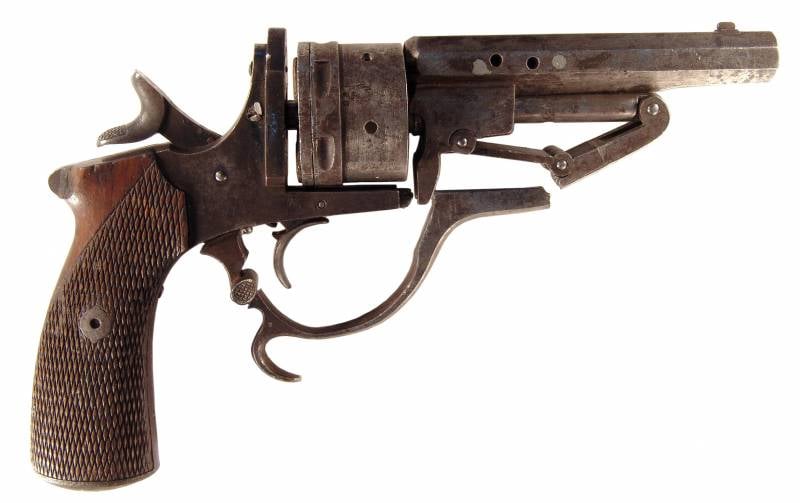
A truly unique photo, which simply has no price: Galan revolver with the inscription on the barrel: “N.I. Goltyakov. 1879. Head. No. 780 "from the Perm Museum of Local Lore. Museum item number - POKM # 100500. As you can see, our "responsible bodies" have worked hard on this revolver with might and main - drilled holes in it from the heart! But the fact that the lever is broken on it primarily indicates the low quality of the steel. And pay attention to the trigger without the striker. This means that we have before us a rare specimen with a "transfer fight"!
It often happens that, due to some circumstances, it is easier to make a completely unique weapon as a gift to the sovereign, than to produce the same weapon in series. And for some reason this often happened in Russia. To make in one copy - no problem, but to repeat in thousands and with the required quality is not possible ...
The old man's mind was knocked out.
And Balda condemned with reproach:
"You would not chase, pop, for cheapness."
("The Tale of the Priest and His Worker Balda", A. Pushkin)
Weapons and firms. In the last article in this series, we talked about the Galan revolver, which for some time was in service with the Russian imperial fleet... But they ordered it in Belgium. And I wanted it to be produced in Russia. And so our big bosses looked around, looked at the expensive gifts made to him from the artisans and decided that the production of "Galans" in Russia could be entrusted to the master Nikolai Ivanovich Goltyakov, a well-known weaponsmith at that time, who performed and piece orders for the princes of the imperial house.
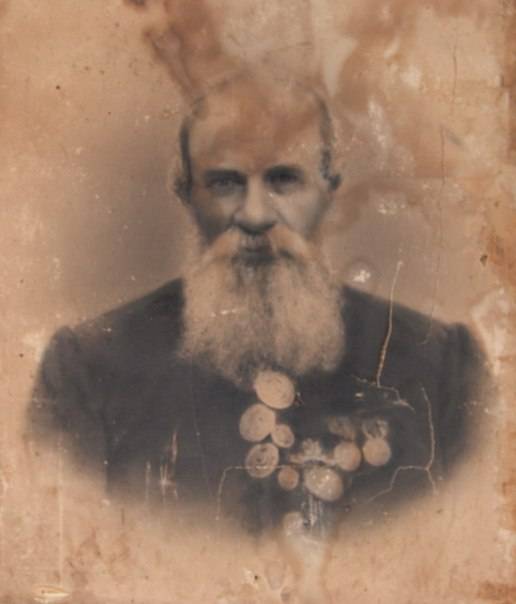
Portrait of N.I. Goltyakov in the late XNUMXth - early XNUMXth centuries
What can you say about him? Yes, only that there have always been and are people who not only have their hands growing from where they should be, but also apply a special talent to any business. Russia has always been famous for such people, and just Goltyakov (1815-1910) was one of them. He was a gunsmith who owned a small factory in Tula. And he made excellent hunting and military weapons, as well as, of course, also samovars!
After graduating from the parish school, he studied within the walls of the Tula arms factory. And having succeeded in business, already in 1840 he opened his own workshop, where he made hunting rifles to order. And he made them of such high quality that he attracted the attention of splendid princely persons and in 1852 he even received the title of arms master “Their Imperial Highnesses Vel. Princes Nicholas and Mikhail Nikolaevich ”and a very responsible right to put the imperial coat of arms on their products. In 1862 he was awarded a silver medal on the Vladimir ribbon, and in 1864 he was awarded a gold watch from the same grand dukes. In the same year he became a merchant of the second guild. And since 1866, he started producing and selling revolvers of his own production to gentlemen officers of the Russian Imperial Army. It is clear that he did not invent anything new, but made copies of foreign revolvers, but they were of such high quality and had so many improvements that in 1868 he was able to get a privilege to manufacture them and the right to sell them throughout the country! He presented two of his revolvers and a revolver rifle to Alexander II himself, and today they are kept in the collection of the Hermitage. The year 1873 was marked with a new success, when he also became a supplier of weapons for the court of King George I of Greece. The master's sons, Nicholas and Paul, continued their father's work and also became armourers. And so he was asked to produce domestic "Galans" for the fleet ...
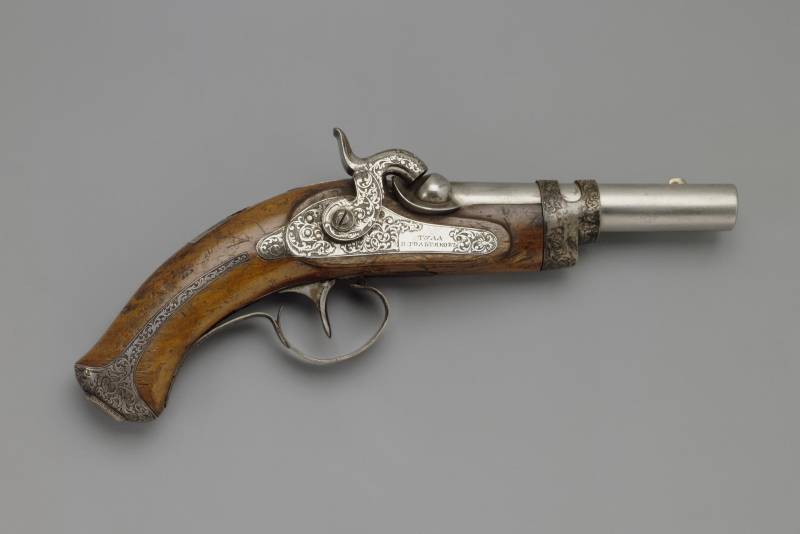
Capsule pistol by Petr Korneevich Goltyakov, 1845. Material: steel, wood, silver. Technique: forging, carving, chasing, engraving, nielloing, inlaying. Dimensions: l. 27,8 cm; caliber 13 mm. Photo of the State Hermitage Museum, St. Petersburg
History with the "Russian Galan" began in 1872. Grand Duke Konstantin Nikolaevich personally ordered that this revolver be sent to Tula N.I. Goltyakov, and so that he, the court gunsmith and supplier to the court of His Imperial Majesty, would make 10 such revolvers for testing.
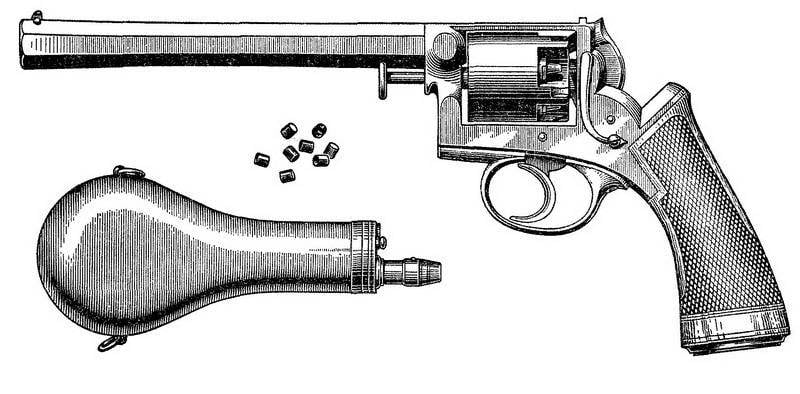
Revolver Goltyakov, powder flask and capsules. Illustration from the book by A.B. Beetle "Revolvers and pistols"
It took only six weeks when Goltyakov really presented five Galans for trial tests, and he took care of giving them a more elegant look. For which he reduced some of the details in size. And during the tests in all these five revolvers broke ... one and the same very important detail - the axis of the drum, on which the entire structure of this revolver was held.
As a result, on March 15, 1873, Rear Admiral Schwartz, Chairman of the Naval Technical Committee, reported to the Naval Ministry office that Goltyakov was not yet able to produce Galan revolvers of the required quality, so he could not be given an order for their mass production. In response, the master asked for permission to remake the samples given to him and, moreover, replace the cast steel from Zlatoust with foreign ones. But the Artillery Department of the Naval Technical Committee refused to replace him, and why is very clear. The weapons produced in Russia had to be as cheap as possible. Therefore, everything that raised the cost of production directly on the ground was immediately swept aside, including more expensive imported steel.
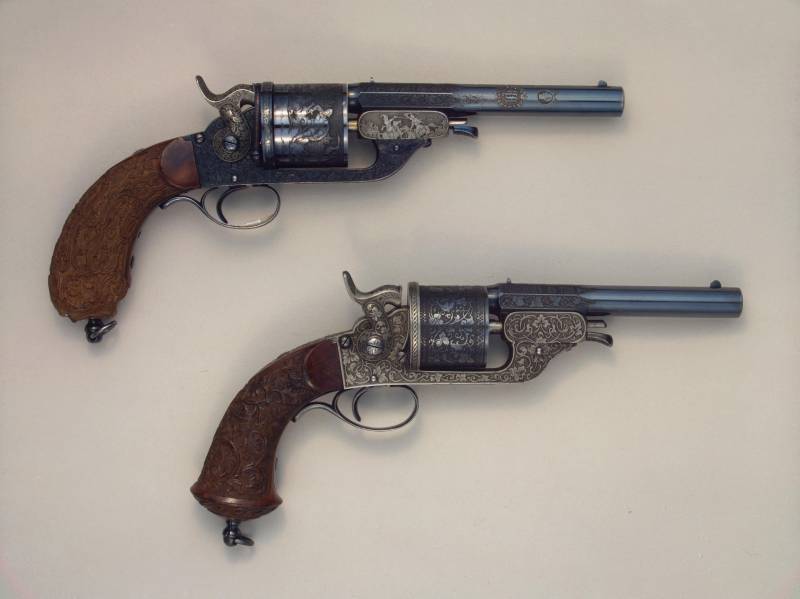
Revolvers made by master Goltyakov. Time of creation: between 1875-1880 Production center: Tula. Material: steel, wood. Technique: forging, carving, engraving. Dimensions: length 31 cm.Photo by the State Hermitage Museum, St. Petersburg
And then in March 1873, after making sure that Goltyakov's revolvers are worse than the Belgian ones, he decided to place an order for 1033 revolvers and 154 cartridges in Belgium. Meanwhile, at the end of the same year, Goltyakov provided the artillery department with the revised Galans, and this time they turned out to be of quite high quality. So high quality that they were later shown at the Moscow Polytechnic Exhibition. But they did not order revolvers after that. Belgium was considered better than Tula.
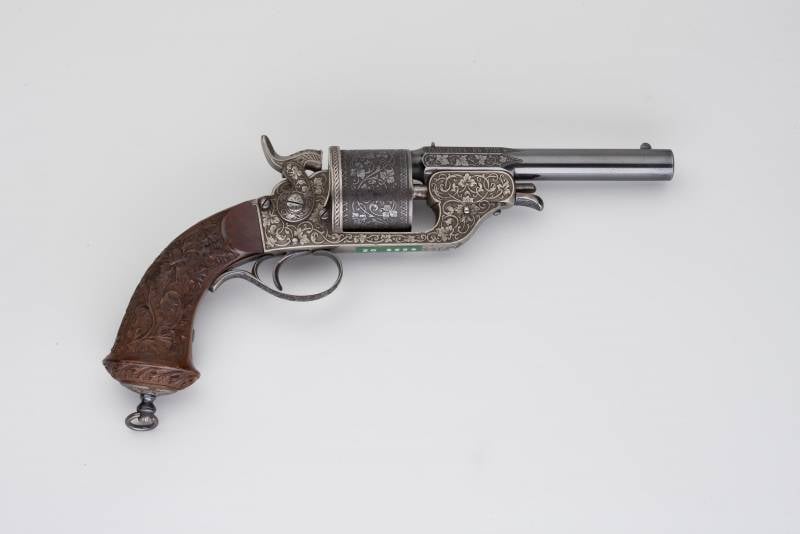
One of these revolvers. Its graceful engraving is clearly visible. Photo of the State Hermitage Museum, St. Petersburg
Goltyakov, however, did not calm down. I made a few more revolvers, gave them for testing, and they showed quite satisfactory results. The Naval Ministry immediately caught on and ordered Nikolai Ivanovich a sample batch of 500 pieces, and if the batch was of high quality, it was planned to conclude a contract for the supply of another 5500 Tula "Galans". The steel was to be used by the Obukhov plant. The frame had to be made of ductile iron. It is interesting that Nikolai Ivanovich even suggested a sleeve of his own design for the Galan cartridge. That is, all the advantages of placing an order at his enterprise were obvious.
But ... a quick order did not follow to Goltyakov. Only in 1876 a contract was signed with him for the supply of 5000 revolvers for the Russian Imperial Navy. Differences between the Belgian and Russian "Galans" are interesting, concerning the design itself, and not just the grade of steel from which they were made.
So, the central rod of the Tula revolver had a smaller cutout for the rear lever hinge than the Belgian model revolver. This means that the levers of the Tula revolvers were thinner. The smaller the cut, the greater the strength of the central bar, which at first proved to be unsatisfactory. Although the Belgian revolvers had no problems with its durability. Most likely, the breakdowns were associated with the low quality of the steel or the peculiarities of the hardening of this part at the Goltyakov factory.
But the main difference was the design of the striker, or "transfer fight". The fact is that Belgian revolvers had a firing pin on the trigger and represented one detail with it, like many other revolvers of that time. For some reason, the firing pin on Goltyakov's revolver was made in the form of a separate part. That is, the trigger in it did not hit the primer directly, but hit the spring-loaded striker, and already that one - struck the primer. Then such a striker device found wide application, although, in general, there are no special practical benefits in it. Moreover: in the "Weapon collection" No. 4 for 1880, in the materials of the Artillery Department of the Naval Technical Committee, there is a memorandum from Lieutenant Kulakov about the "pistol-revolvers of Master Goltyakov presented for delivery to the Naval Department." And there it is said that the "transfer fight" he proposed "instead of the usual hammer with a striker, adopted in the Galan system, requires a stronger spring" and creates inconvenience due to the complexity of the device and the large number of small parts and springs that "serve to transfer hitting the trigger on a pistol cartridge. Lieutenant Kulakov proposed to simplify this Goltyakov mechanism so that instead of six parts it would have only three parts. But in the same footnote it is written that the version proposed by Goltyakov was approved in 1878 and adopted as a model.
The Goltyakov's enterprise clearly lacked the capacity to process the order, as evidenced by his request to write off a fine for late delivery of the next delivery. As a result, in 1876, he was able to produce only about 180 revolvers, and the third hundred in 1877.
It is interesting that when Goltyakov handed over 117 revolvers for acceptance, 111 of them were not accepted precisely because of the defects of the "transfer fight", a large number of misfires and even such a shortcoming as the fragility of the striker mechanism. But all six revolvers with triggers of a conventional device were accepted - there were no complaints about them.
Here Lieutenant Kulakov himself began to improve the Tula "Galan". The "pass-through" redesigned at his suggestion gave the least misfires, provided a blow to the center of the primer, and the blunt toe of his firing pin did not pierce, which mattered. The force of the spring became less, although it had to be protected from moisture, and in a round-the-world voyage, as the members of the commission considered, this would be a rather difficult matter.
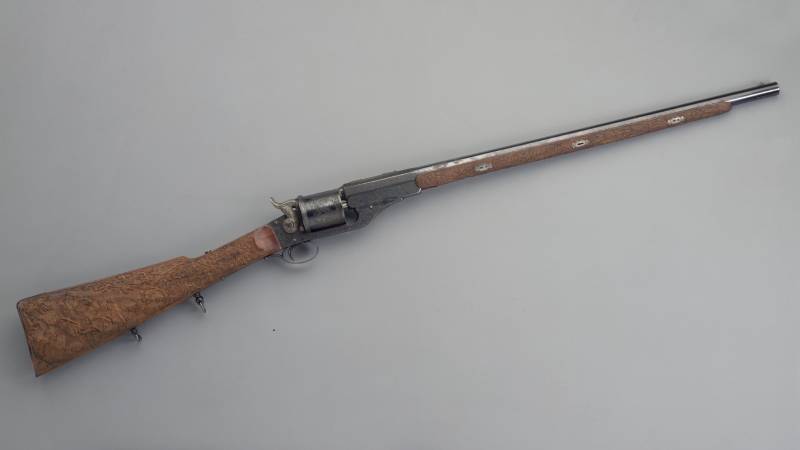
The Goltyakov revolving rifle, which belonged to Alexander II. Time of creation: 1875-1880 Material: steel, wood. Technique: forging, carving, chasing, engraving, bluing, polishing. Dimensions: total length: 109,6 cm; barrel length: 64,0 cm; caliber 14,0 mm. Photo of the State Hermitage Museum, St. Petersburg
The question arose of what kind of alteration should now be required from Goltyakov. The simplest solution would be not to be smart, but to do everything the same as it was on the Belgian revolver. But then 160 new frames and 233 new triggers would have to be made. Again the question of cheapness arose, which is why it was decided to remake the revolvers at the suggestion of Kulakov. However, it was necessary to check whether such revolvers could be used on ships in sea navigation, and whether the parts of their "transfer battle" would corrode.
As a result, three "varieties" of the same revolver entered service with the fleet at once, and they were produced at the same enterprise (just some miracle of miracles!): A variant with a trigger, like a Belgian revolver, a model with a "transfer fight ", Invented by Goltyakov, and the" transfer battle "of Lieutenant / Staff Captain Kulakov.
Goltyakov's relationship with sailors, unlike the grand dukes, was very specific and by no means kind-hearted. Moreover, they even made a special stamp that was put on defective parts ("VB") so that Goltyakov ... would not try to insert them into his new revolvers, that is, even this kind of fraud took place! And this was done to stop it! But Goltyakov was constantly receiving complaints about various "objective reasons" that prevented him from fulfilling the order on time and with the required quality. In general, the contract was fulfilled anyway, but slowly. Moreover, the revolvers were not cheap - 23 rubles a piece. Meanwhile, back in 1871, Goltyakov promised that for the Tula Arms Plant he would make 500 Colt revolvers at a price of 13 rubles apiece and another 500 Lefoshe at a price of 17 rubles. There were a lot of defects, in a word - the usual problems of our mass production. Nevertheless, in 1880, the fleet from Goltyakov was able to receive its ordered batch of 1000 revolvers.
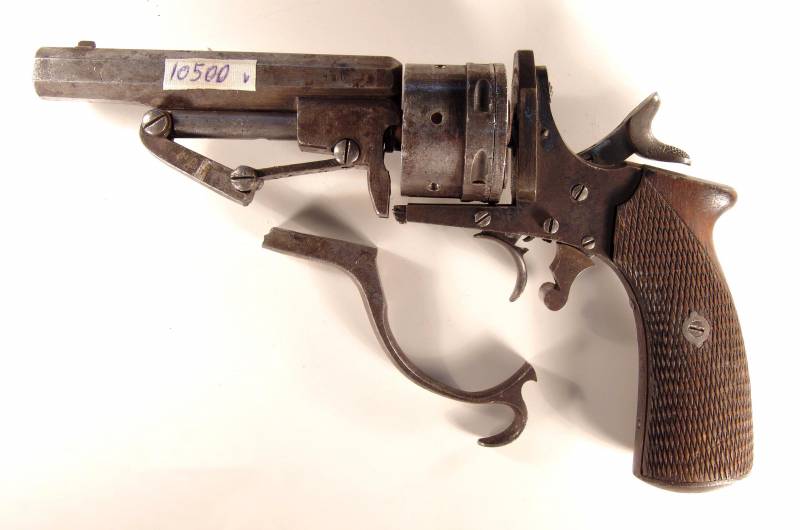
Revolver Galan with an inscription on the barrel: “Tula factory of N.I. Goltyakov. 1879. Head. No. 780 "from the Perm Museum of Local Lore. Left view.
In 1881, the Naval Ministry had already decided to organize the production of Galan revolvers at the Imperial Tula Arms Factory, and to produce a model with the changes made by the receiver - the same Kulakov, but who had already received the rank of staff captain! But ... by this time so many Smith-Wessons had already arrived in Russia that it was decided to abandon this "national project".
In general, this whole story has shown one thing - a private Russian enterprise was able to produce piece weapons of very high quality, but ... it was not capable of producing a mass product with the same high quality. That is, it was easier to pay foreigners and forget about any headache than to get involved in a long and unpleasant gimmick with domestic producers, and in monetary terms, this did not even give much benefit!
PS The author and administration of the site express their sincere gratitude to the chief curator of the Perm Museum of Local Lore, N.Ye. Sokolova. for the photographs of the "Perm" revolver "Galan" and the Deputy General Director of the State Hermitage Museum, chief curator Adaksina S. B. for permission to use his photographs.
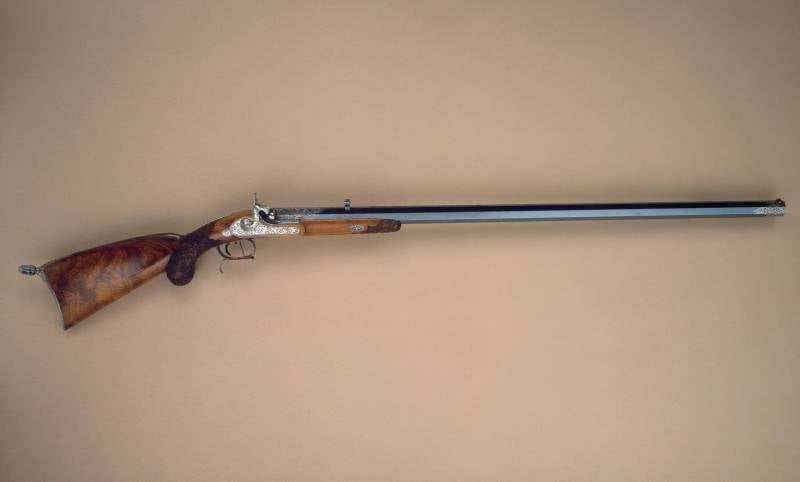
Information